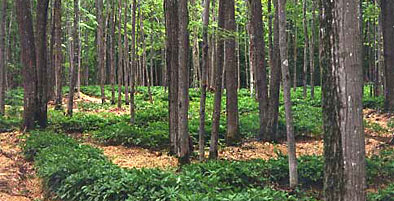When producing charcoal in a kiln, it’s important to protect your hands with insulated leather gloves. Leather gloves without insulation will not provide enough protection against the heat of the kiln. It’s also important to wear closed-toed shoes., preferrabley leather work boots.
Kilns for charcoal production come in a variety of styles. A common feature of all kilns is the ability to control oxygen. The control of oxygen within the kiln is critical during the charcoal making process as is the ability to “close down the kiln”, i.e., shut off the flow of oxygen to finish the charring process. The kiln used in this demonstration requires a small fire at the base. A long stick placed in the center and protruding through a vent in the kiln allows access to the wood for initially lighting the fire after the kiln is fully loaded. The wood is packed/loaded as densely aspossible to maximize the charcoal yield.
While log length is not important except for ease of loading, logs/wood thickness is important. Pieces of similar diameter/thickness should be loaded to insure evenly charred pieces at the end of the burning process. Smaller diameter/thickness pieces combined with bigger pieces of wood will result in lower yields as as the smaller pieces burn up and leave ash and the larger pieces do not have time to completely char resulting in unfinished pieces , called “brands”.. The kiln should be loaded as tighlty as possible. The more wood that can be fit into the kiln, the greater the charcoal yield will be.
When lighting a kiln, it’s important to consider the type of fuel used to start the flame. A mix of Diesel fuel and oil or kerosene is recommended over straight gasoline. Gasoline is too volatile and can explode. Adam Downing, Agriculture and Natural Resources Extension Agent, demonstrates the process of lighting, sealing and controlling the heat within the kiln. During charcoal production, control of the heat is critical to the outcome of the product. The fire should burn towards the bottom where the oxygen is allowed to enter the kiln through vents. By opening and closing various vents and using stacks, the oxygen and therefore the heat, can be controlled and dispersed evenly. This ensures that the wood is charred in a uniform manner.
Once the wood has turned into charcoal, it’s necessary to close off the kiln. This involves starving the fire of oxygen. Sand is spread around the bottom barrel where the holes are located. The top barrel or afterburner is removed and the lid is secured on the bottom barrel which contains the charred wood. After everything has cooled the following day, the charcoal can be removed safely. It’s best not to handle the pieces too much as they are very fragile and fall apart easily. Large chunks are preferred by most grillers for the simple fact of staying ontop of the charcoal grate in their grill.
